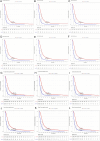Development and validation of nomogram model predicting overall survival and cancer specific survival in glioblastoma patients
- PMID: 40249416
- PMCID: PMC12008090
- DOI: 10.1007/s12672-025-02331-7
Development and validation of nomogram model predicting overall survival and cancer specific survival in glioblastoma patients
Abstract
Background: Identifying the incidence and risk factors of Glioblastoma (GBM) and establishing effective predictive models will benefit the management of these patients.
Methods: Using GBM data from the Surveillance, Epidemiology, and End Results (SEER) database, we used Joinpoint software to assess trends in GBM incidence across populations of different age groups. Subsequently, we identified important prognostic factors by stepwise regression and multivariate Cox regression analysis, and established a Nomogram mathematical model. COX regression model combined with restricted cubic splines (RCS) model was used to analyze the relationship between tumor size and prognosis of GBM patients.
Results: The incidence of GBM has been on the rise since 1978, especially in the age group of 65-84 years. 11498 patients with GBM were included in our study. The multivariate Cox analysis revealed that age, tumor size, sex, primary tumor site, laterality, number of primary tumors, surgery, chemotherapy, radiotherapy, systematic therapy, marital status, median household income, first malignant primary indicator were independent prognostic factors of overall survival (OS) for GBMs. For cancer-specific survival (CSS), race is also independent prognostic factors. Additionally, risk of poor prognosis increased significantly with tumor size in patients with tumors smaller than 49 mm. Moreover, our nomogram model showed favorable discriminative ability.
Conclusion: At the population level, the incidence of GBM is on the rise. The relationship between tumor size and patient prognosis is still worthy of further study. Moreover, the proposed nomogram with good performance was constructed and verified to predict the OS and CSS of patients with GBM.
Keywords: Cancer-specific survival; Glioblastoma; Overall survival; Prognostic nomogram; SEER.
© 2025. The Author(s).
Conflict of interest statement
Declarations. Consent for publication: Not applicable. Competing interests: The authors declare no competing interests.
Figures








Similar articles
-
Prognostic model for predicting overall survival in patients with glioblastoma: an analysis based on the SEER database.J Investig Med. 2023 Apr;71(4):439-447. doi: 10.1177/10815589221147153. Epub 2023 Jan 10. J Investig Med. 2023. PMID: 36935629 Clinical Trial.
-
Identification of prognostic factors for predicting survival of patients with malignant adrenal tumors: A population-based study.Front Oncol. 2022 Oct 17;12:930473. doi: 10.3389/fonc.2022.930473. eCollection 2022. Front Oncol. 2022. PMID: 36324596 Free PMC article.
-
[Development and Evaluation of Prognostic Nomogram Model for Adult Ventricle Glioma Patients].Sichuan Da Xue Xue Bao Yi Xue Ban. 2022 Jul;53(4):588-596. doi: 10.12182/20220760203. Sichuan Da Xue Xue Bao Yi Xue Ban. 2022. PMID: 35871728 Free PMC article. Clinical Trial. Chinese.
-
Long-Term Time Series Forecasting and Updates on Survival Analysis of Glioblastoma Multiforme: A 1975-2018 Population-Based Study.Neuroepidemiology. 2022;56(2):75-89. doi: 10.1159/000522611. Epub 2022 Feb 16. Neuroepidemiology. 2022. PMID: 35172317 Review.
-
Epidemiology and Outcome of Glioblastoma.In: De Vleeschouwer S, editor. Glioblastoma [Internet]. Brisbane (AU): Codon Publications; 2017 Sep 27. Chapter 8. In: De Vleeschouwer S, editor. Glioblastoma [Internet]. Brisbane (AU): Codon Publications; 2017 Sep 27. Chapter 8. PMID: 29251870 Free Books & Documents. Review.
References
-
- McKinnon C, Nandhabalan M, Murray SA, Plaha P. Glioblastoma: clinical presentation, diagnosis, and management. BMJ. 2021;14(374): n1560. 10.1136/bmj.n1560. (PMID: 34261630). - PubMed
-
- Tesileanu CMS, Dirven L, Wijnenga MMJ, Koekkoek JAF, Vincent AJPE, Dubbink HJ, Atmodimedjo PN, Kros JM, van Duinen SG, Smits M, Taphoorn MJB, French PJ, van den Bent MJ. Survival of diffuse astrocytic glioma, IDH1/2 wildtype, with molecular features of glioblastoma, WHO grade IV: a confirmation of the cIMPACT-NOW criteria. Neuro Oncol. 2020;22(4):515–23. 10.1093/neuonc/noz200. - PMC - PubMed
-
- Hansen S, Rasmussen BK, Laursen RJ, et al. Treatment and survival of glioblastoma patients in Denmark: the Danish neuro-oncology registry 2009–2014. J Neurooncol. 2018;139(2):479–89. 10.1007/s11060-018-2892-7. - PubMed
-
- Omuro A, DeAngelis LM. Glioblastoma and other malignant gliomas: a clinical review. JAMA. 2013;310(17):1842–50. 10.1001/jama.2013.280319. (PMID: 24193082). - PubMed
-
- Adegboyega G, Kanmounye US, Petrinic T, Ozair A, Bandyopadhyay S, Kuri A, Zolo Y, Marks K, Ramjee S, Baticulon RE, Vaqas B, InciSion UK Collaborative. Global landscape of glioblastoma multiforme management in the stupp protocol Era: systematic review protocol. Int J Surg Protoc. 2021;25(1):108–13. 10.29337/ijsp.148. - PMC - PubMed
Grants and funding
- gzwkj2021-204/Science and Technology Fund of Guizhou Provincial Health Commission
- 82360376/National Natural Science Foundation of China
- 82360482/National Natural Science Foundation of China
- gzwjrs2024-007/Guizhou Province's funding for the cultivation of high-level innovative talents through the Thousand Talents Program
- gzwjrs2023-001/Guizhou Province's funding for the cultivation of high-level innovative talents through the Thousand Talents Program
LinkOut - more resources
Full Text Sources
